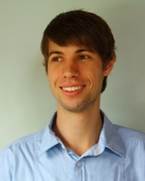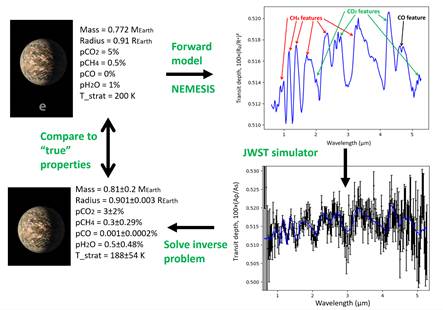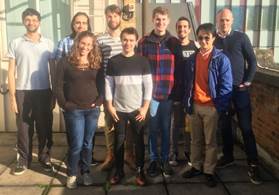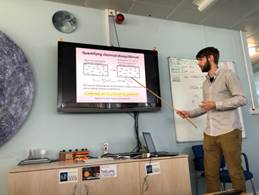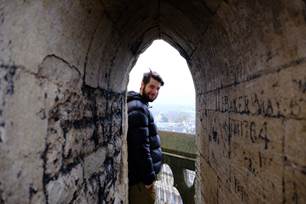|
|
|
Research
Rotation Write-up Earth and Space Sciences and Astrobiology grad student
Josh Krissansen-Totton’s research rotation took him to the “dreaming spires” of
Oxford to learn how astronomers might search for life on distant
exoplanets. By
Joshua Krissansen-Totton Graduate
Student, Earth and Space Sciences and Astrobiology
The
logical next step in this work was to ask whether this combination of gases
could be detectable with future telescopes such as the James Webb Space
Telescope (JWST). Simulating astronomical observations of exoplanets is
outside my skill set as an Earth and planetary scientist, and so it seemed
like a perfect project for an astrobiology rotation! I traveled to Oxford to
work with Professor Patrick Irwin in the Department of Physics. Professor
Irwin’s group uses their in-house radiative transfer code NEMESIS, which
simulates the physics of radiation passing through planetary atmospheres. The
code can be used to simulate exoplanet transits, whereby an exoplanet crosses
in front of its host star and some of the stellar light received at Earth
passes through the exoplanet’s atmosphere. Because different gases absorb
light at different wavelengths, the size of the planet (i.e. the transit
depth) appears to vary with wavelength. Thus, the transit spectrum of an
exoplanet can be used to detect and quantify the gases present in an exoplanet’s
atmosphere. Fortunately,
the wavelength range of JWST is ideally suited to detecting atmospheric gases
such as CO2, CH4, and carbon monoxide (CO) (Fig. 1, top
right). The detection of CO is important because many of the nonbiological scenarios that produce CH4 would
also be expected to produce CO, and so it will be important to check for CO
to rule out these cases. However,
actual JWST observations will not be as precise as theoretical calculations,
and so I needed to ‘degrade’ the true spectrum and simulate JWST observations
with realistic astronomical and instrument noise. I achieved this using the
open source PandExo instrument simulator
(Batalha et al. 2017). Finally,
given noisy JWST observations, I wanted to know how well atmospheric constituents
could be constrained from these observations. I used the ‘Nested Sampling’
retrieval algorithm to calculate probability distributions for planet
properties from the noisy spectra. The whole procedure is shown in Fig.
1. The probability I obtained for properties like CH4 and
CO2 concentrations show how well these gases can be
constrained by JWST observations.
Preliminary
results are promising. I found that after observing ~10 transits of
TRAPPIST-1e with JWST, it ought to be possible to detect CH4, CO2,
and perhaps put some tentative upper bounds on CO. I also did calculations
simulating observations of a modern Earth-like atmosphere and found that
oxygen/ozone is much harder to detect than CH4 and CO2 in
the early Earth scenario. This means that not only is the CH4/CO2 biosignature
combination probably more common than oxygen biosignatures (Krissansen-Totton
et al. 2018), but it is also easier to detect with JWST. I found that
Earth-like clouds shouldn’t interfere with observations significantly,
although stellar heterogeneity and variability will be a major challenge. I
am currently working on writing up these results for a paper. In
addition to my research project, doing my rotation in the UK provided many
opportunities for travel and professional networking. I presented my work at
a seminar at the University of Exeter (Fig. 2), a Planets workshop
held in Oxford, and traveled to the Azores for a geoscience conference. I am
thankful to Professor Irwin and his research group (pictured in Fig.
3) for welcoming me into their group and spending a lot of time
helping me set up the NEMESIS code. The Atmospheric, Oceanic, and Planetary
physics group at Oxford was a very pleasant and friendly environment to
work! I had a wonderful time living and working in Oxford University
for a few months. Thanks to Professor Irwin and his group, and funding
provided by the UW Astrobiology Program I was able to expand my research into
astronomy, make valuable professional connections and collaborations, and
experience living in the wonderful city of Oxford. Right -
Fig. 3: Professor Patrick Irwin’s research group at the University
of Oxford.
References: Batalha, N. E., Mandell, A.,
Pontoppidan, K., Stevenson, K. B., Lewis, N. K., Kalirai,
J., ... & Nielsen, L. D. (2017). PandExo:
a community tool for transiting exoplanet science with JWST & HST. Publications
of the Astronomical Society of the Pacific, 129(976), 064501. Krissansen-Totton, J., S. Olson, D. C Catling (2018).
Disequilibrium biosignatures over Earth history and implications for
detecting exoplanet life, Science Advances, 4, eaao5747,
DOI:10.1126/sciadv.aao5747. |
|
THIS E-NEWSLETTER WAS SENT BY:
|

